Serving 180 students in grades Kindergarten-8, Ocean Studies Charter ranks in the top 30% of all schools in Florida for overall test scores (math proficiency is top 30%, and reading proficiency is top 30%).
The percentage of students achieving proficiency in math is 60-64% (which is higher than the Florida state average of 52%). The percentage of students achieving proficiency in reading/language arts is 65-69% (which is higher than the Florida state average of 52%).
The student:teacher ratio of 11:1 is lower than the Florida state level of 17:1.
Minority enrollment is 42% of the student body (majority Hispanic), which is lower than the Florida state average of 65% (majority Hispanic).
Quick Stats (2025)
- School Type: Charter School
- Grades: Kindergarten-8
- Enrollment: 180 students
- Student:Teacher Ratio: 11:1
- Minority Enrollment: 42%
- Overall Testing Rank: Top 30% in FL
- Math Proficiency: 60-64% (Top 30%)
- Reading Proficiency: 65-69% (Top 20%)
- Science Proficiency: 40-59% (Top 50%)
- Source: National Center for Education Statistics (NCES), FL Dept. of Education
Top Rankings
Ocean Studies Charter ranks among the top 20% of public schools in Florida for:
Category
Attribute
Reading/Language Arts Proficiency
Community Size
School Overview
Ocean Studies Charter's student population of 180 students has grown by 80% over five school years.
The teacher population of 16 teachers has grown by 1500% over five school years.
School Type
Grades Offered
Grades Kindergarten-8
Total Students
180 students
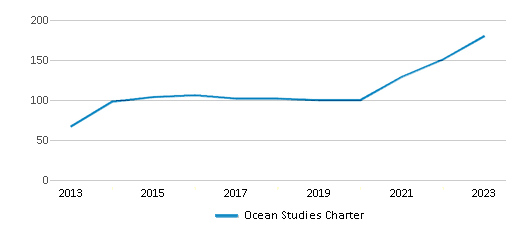
Gender %

Total Classroom Teachers
16 teachers
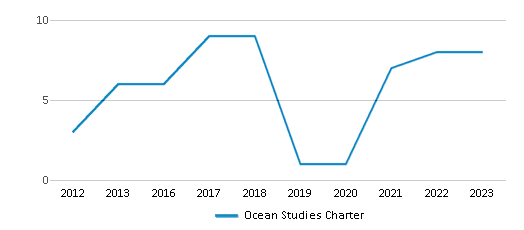
Students by Grade
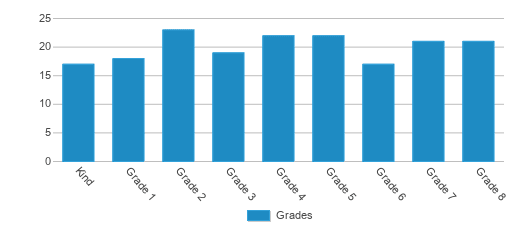
School Rankings
Ocean Studies Charter ranks within the top 30% of all 3,704 schools in Florida (based off of combined math and reading proficiency testing data).
The diversity score of Ocean Studies Charter is 0.56, which is less than the diversity score at state average of 0.70. The school's diversity has stayed relatively flat over five school years.
Overall Testing Rank
#854 out of 3704 schools
(Top 30%)
(Top 30%)
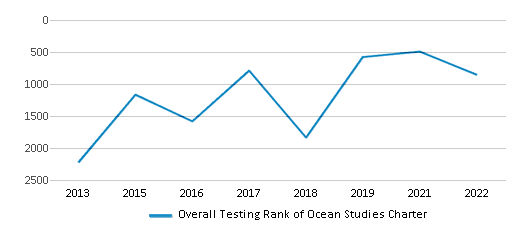
Math Test Scores (% Proficient)
60-64%
52%
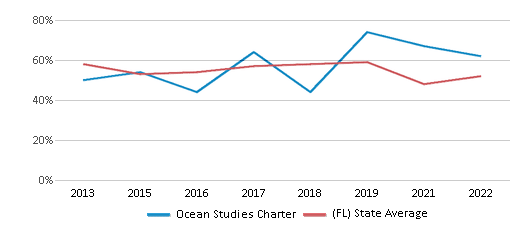
Reading/Language Arts Test Scores (% Proficient)
65-69%
52%
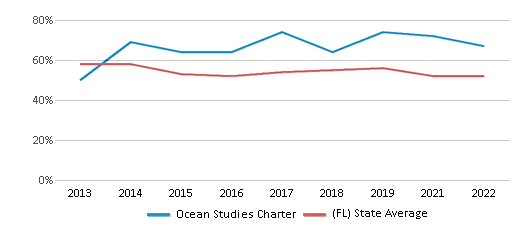
Science Test Scores (% Proficient)
40-59%
52%
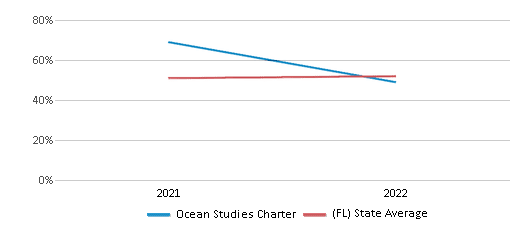
Student : Teacher Ratio
11:1
17:1
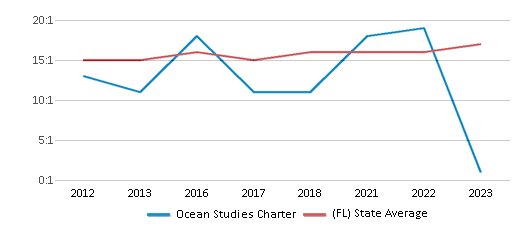
American Indian
n/a
n/a
Asian
1%
3%
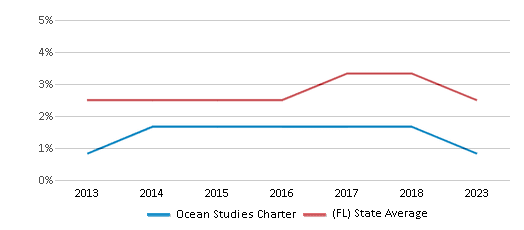
Hispanic
32%
37%
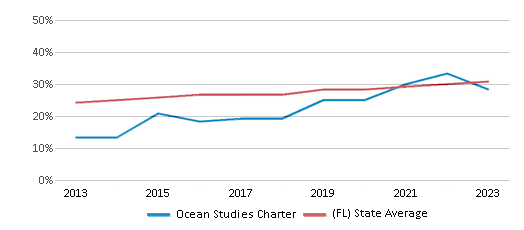
Black
n/a
21%
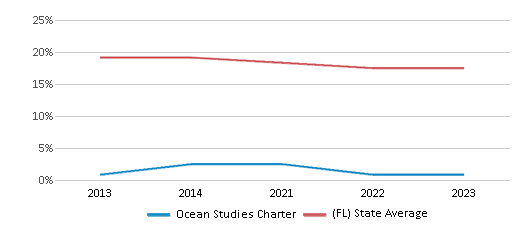
White
58%
35%
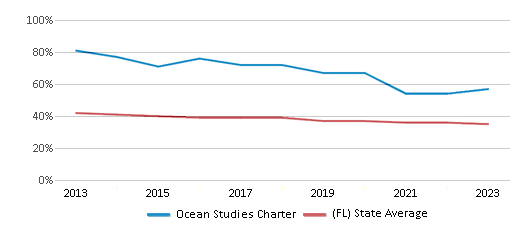
Hawaiian
n/a
n/a
Two or more races
9%
4%
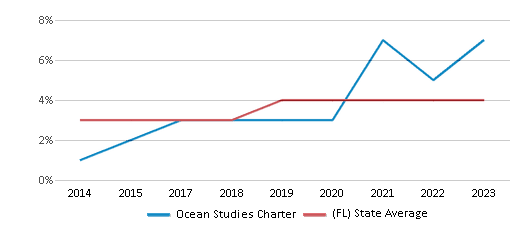
All Ethnic Groups
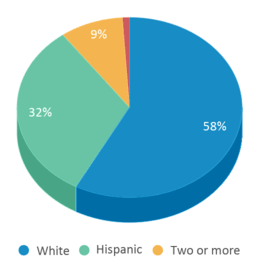
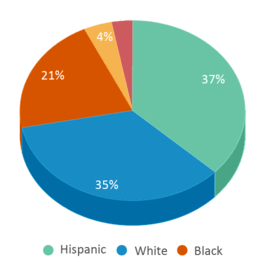
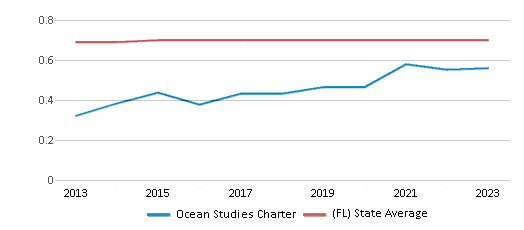
Participates in the National School Lunch Program (NSLP)
Yes
Eligible for Free Lunch
19%
47%
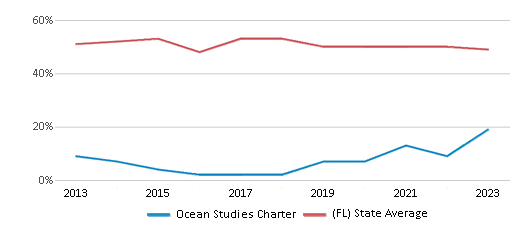
Eligible for Reduced Lunch
2%
4%
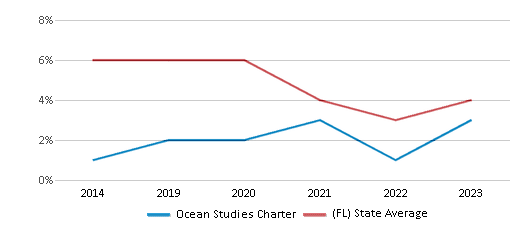
School Statewide Testing
School District Name
Source: National Center for Education Statistics (NCES), FL Dept. of Education
Profile last updated: 02/09/2025
Frequently Asked Questions
What is Ocean Studies Charter's ranking?
Ocean Studies Charter is ranked #854 out of 3,704 schools, which ranks it among the top 30% of public schools in Florida.
What schools are Ocean Studies Charter often compared to?
Ocean Studies Charteris often viewed alongside schools like Treasure Village Montessori Charter School, Plantation Key School by visitors of our site.
What percent of students have achieved state testing proficiency in math and reading?
60-64% of students have achieved math proficiency (compared to the 52% FL state average), while 65-69% of students have achieved reading proficiency (compared to the 52% FL state average).
How many students attend Ocean Studies Charter?
180 students attend Ocean Studies Charter.
What is the racial composition of the student body?
58% of Ocean Studies Charter students are White, 32% of students are Hispanic, 9% of students are Two or more races, and 1% of students are Asian.
What is the student:teacher ratio of Ocean Studies Charter?
Ocean Studies Charter has a student ration of 11:1, which is lower than the Florida state average of 17:1.
What grades does Ocean Studies Charter offer ?
Ocean Studies Charter offers enrollment in grades Kindergarten-8
What school district is Ocean Studies Charter part of?
Ocean Studies Charter is part of Monroe School District.
School Reviews
2 1/20/2020
The marine science teacher is rude and does not keep us parents up to date on the field trips.
3 7/19/2017
Our experience is mixed. Yet, the curriculum is great and our child is happy and learning, but with the prospect of possibly facing yet another new teacher next year. We do have our concerns. In addition, one of the other parents told me he looked up info on the instructional staff and only a couple of the teachers are actually qualified or experienced to teach at a public school. Not sure how this information compares to other schools in the area. But, this may be a difference between private and public schoolsThis school has had such a high staff turn over the past couple of years. Both support and instructional. This year they tried a new admin and still they have gone thru their complete office staff and from what several other parents are finding out, they are losing almost half of their classroom teachers. Not sure what fix is needed, but not certain our daughter is going back next year. (Have already applied to another local charter school, we feel a good school and their students need consistency)
Review Ocean Studies Charter. Reviews should be a few sentences in length. Please include any comments on:
- Quality of academic programs, teachers, and facilities
- Availability of music, art, sports and other extracurricular activities
Recent Articles

What Is A Charter School?
Explore the world of charter schools in this comprehensive guide. Learn about their history, how they operate, and the pros and cons of this educational innovation. Discover key facts about charter schools, including admission policies, demographics, and funding, as well as what to look for when considering a charter school for your child.

10 Reasons Why High School Sports Benefit Students
Discover the 10 compelling reasons why high school sports are beneficial for students. This comprehensive article explores how athletics enhance academic performance, foster personal growth, and develop crucial life skills. From improved fitness and time management to leadership development and community representation, learn why participating in high school sports can be a game-changer for students' overall success and well-being.

February 05, 2025
Understanding the U.S. Department of Education: Structure, Impact, and EvolutionWe explore how the Department of Education shapes American education, from its cabinet-level leadership to its impact on millions of students, written for general audiences seeking clarity on this vital institution.









